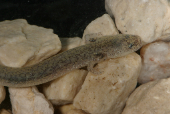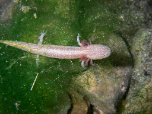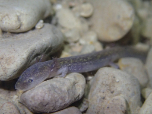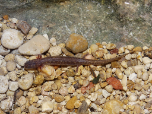Barton Springs Salamander (Eurycea sosorum)
Description: Barton Springs salamanders grow to approximately 2.5 inches in total length and have mottled coloration varying from darkish purple to light yellow on their dorsal side. The variation in coloring is largely due to the presence or lack of melanophores, iridophores, and pigment gaps. The ventral side of the salamander is either a cream or translucent color which allows stomach contents and the presence of eggs to be visible. The ventral side of the tail has a yellow-orange stripe that extends from the cloaca to the end of the tail. They have a fairly small head with reduced eyes and a slender body with elongated limbs that indicate it occupies a semi-subterranean lifestyle. On either side of the salamander are three red gills with four fingers on the forelimbs and five toes on the hindlimbs. The Barton Springs salamander is an ectothermic species and displays bilateral symmetry.
Habitat: The Barton Springs salamander prefers clear water and are typically found near openings of springs. These salamanders can also be found under rocks or gravel, within aquatic vegetation, and algae. Barton Springs salamanders can live in water depths ranging from 0.33 to 16.40 feet. The springs in which these salamanders inhabit flow year-round and retain a constant temperature of around 68 °F.
Range: It is found only in the Barton Springs segment of the Edwards Aquifer and its contributing zone in Texas.
Found in these States:
TX
Diet: Barton Springs salamanders utilize innate predator recognition and are opportunistic feeders. It appears that they feed primarily on small aquatic crustaceans and planarian flatworms (Dugesia sp.), but can supplement their diet with other items, such as earthworms, snails, leeches, and insect larvae.
Reproduction: Barton Springs salamanders are dioecious, and females can hold up to 40 eggs at a time. The eggs are about 1.5 mm in diameter, surrounded by a jelly-like layer, and are deposited in a cluster on various substrates year-round. In captivity, Barton Springs salamanders display a tail-straddling walk during reproduction. Spermatophores deposited by males on substrate are stored by the female in a spermatheca. The fertilization of their eggs is consistent with most salamanders, which utilize internal fertilization in which sperm are released onto the eggs as they pass through the female reproductive tract.
Status: Listed as Endangered because its extent of occurrence (EOO) is 1,190 km2, it occurs in a single threat-defined location, and there is continuing decline in the extent and quality of its aquatic habitat in Travis County, Texas, USA.
»» Kingdom: Animalia - Animals
»» Phylum: Chordata - Chordates
»» Subphylum: Vertebrata - Vertebrates
»» Class: Amphibia - (Amphibians)
»» Order: Caudata - Salamanders
»» Family: Plethodontidae - Lungless Salamanders
»» Genus: Eurycea
»» Species: Eurycea sosorum - Barton Springs Salamander
This article uses material from the Wikipedia article "Barton Springs Salamander", which is released under the Creative Commons Attribution-Share-Alike License 3.0. Content may have been omitted from the original, but no content has been changed or extended.
|












